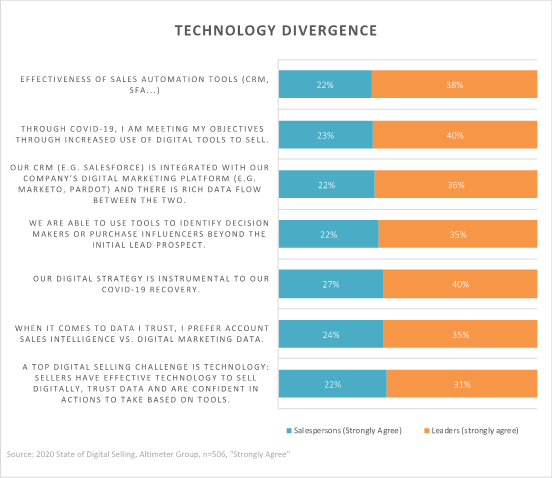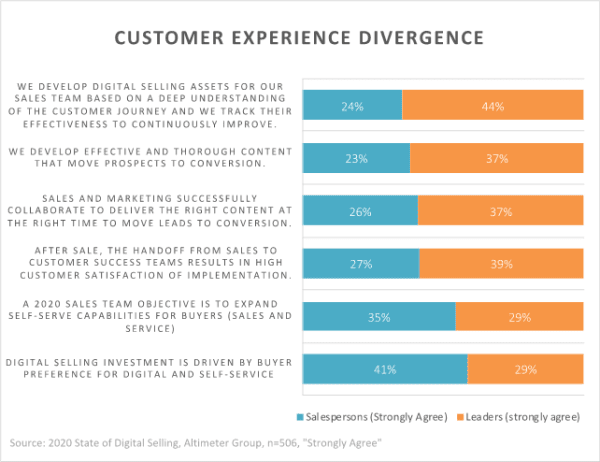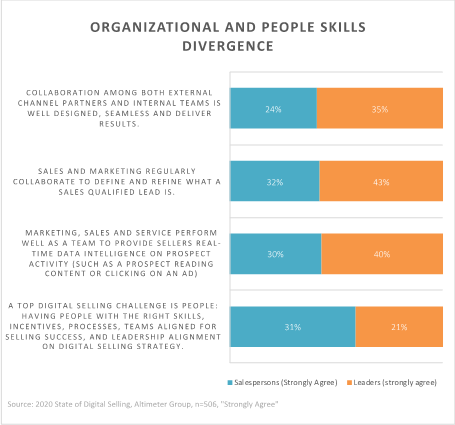BLOG
Why Are Leaders More Optimistic Than Sales Teams About Digital Sales Transformation?
Our research reveals a scary disconnect: Leaders are more positive about transformation than their sales staff.
In our 2020 State of Digital Selling global research report, we found disconnects between the views of front-line sales staff and their leaders. Leaders view their progress in digital sales transformation more positively than sales staff in three areas: technology, customer experience, and organization/people-readiness. This post delves into those disconnects to help leaders and staff better understand their respective sales transformation realities and ends with recommendations on how to close the gap.
Technology & Data
For front-line sales teams, technology is far less effective than what their leaders believe. The largest gap was the effectiveness of foundational CRM and sales automation tools, which only 22% of front-line team members rate “highly effective” vs 38% of leaders. Only 23% of staff strongly believe that increased use of digital tools has helped them meet their objectives through the COVID-19 pandemic, vs 40% of sales leaders.
“The root cause of the tech gap is skills and training.”
One clue that points to the root cause of the tech gap is skills and training: 31% of sales staff say that it is the biggest digital selling transformation challenge, vs. just 21% of leaders—who instead name technology as the greatest transformational challenge.

Customer Experience
Front-line sales staff view customer experience much differently than sales leaders. The front-line would like to expand buyer digital tools to match buyer preference and self-service (41% front line vs. 29% leaders). Front-line sales teams understand CX from direct engagement with customers and prospects, while sales leaders are a step removed and often rely on IT or CX experts to recommend digital tools. To tackle this disconnect, leaders should engage the front-line more in CX development.
The biggest disconnect was the value of content and selling assets: only 24% of front-line staff strongly agree they have the right to sell assets based on the customer journey vs. 44% among managers. Reinforcing this disconnect, only 26% of sales staff strongly agree that sales and marketing successfully collaborate to deliver the right content at the right time to move leads to conversion (vs. 37% of sales leaders). At the end of the sales funnel, only 27% of front-line staff strongly believe the handoff from sales to customer success teams results in high customer satisfaction (vs. 39% of leaders).
In addition, when it comes to content, I hear a consistent story from front-line sales: they don’t know how to select, customize and share (within the customer’s context) content. All too often, content is shared without adequate context from the seller, and this leaves the customer with less reason to read it. This is a training issue. Part of the problem could be the complexity of tools sales teams are asked to use, but training on the “why” and “how” of content is also a challenge.

People & Organization
Front-line sales staff perceive sales and marketing collaboration as much less effective than leaders do. Only 24% of sales staff view collaboration as effective (vs. 35% of leaders). This attitude shows up in two areas: the ability of sales and marketing to collaborate and refine what a sales-qualified lead is (32% staff vs. 43% leaders) and the provision of timely customer intelligence to understand prospects (30% vs. 40%).
No doubt, part of this may be a visibility problem: leaders are more likely to work cross-functionally (including with marketing) than front-line sales. The more problematic issue is the front-line’s view that sales-qualified leads aren’t well-defined, and the fact they’re not getting adequate customer intelligence to understand leads. This should trouble leadership, as both of these issues have a direct impact on the front line’s results. Leaders likely have metrics that indicate access to customer intelligence, but it won’t tell them how effective it was in closing a deal. Of course, an upward trend in usage data indicates growing reliance on it and so is a good indication of ultimate usefulness. If leaders don’t see an upward trend, there’s likely a problem that can be uncovered through direct conversations (or field polling) of the front line—something metrics won’t tell managers.

What It Means & What You Can Do
It’s not unusual to see differences in attitudes by role in our research, but this consistent gap between front-line sales staff and sales leaders drew attention because it was persistent (across all questions we asked). These gaps could hamper the progress of those organizations seeking to digitally transform their sales teams and so are worth paying attention to. Keep the following in mind to successfully transform sales:
- Regularly poll front-line staff to understand their perspective and compare to related metrics like content effectiveness and sales tool enablement adoption. Sales managers and leaders should question those metrics that indicate front-line use of data, content and tools without proof that the front line is truly getting the value A salesperson downloading a white paper to share with a prospect is a vanity metric. It doesn’t indicate whether that content was effectively shared and made a difference in converting the prospect.
- No one likes to take a great salesperson off the front line, but you need to in order to best match transformation tactics to real-world experience. If you have a digital selling transformation council or team, include some of your best sales staff to ensure your whiteboard ambitions address real-world needs. In addition to basic capabilities, tools, etc., involve the front-line in the selection and prioritization of metrics leaders see when it comes to sales enablement.
- Regularly analyze buyer and customer surveys to understand key disconnects, e.g., front-line sales staff see the need for additional customer-facing digital tools that leaders are clearing missing. You’ll discover those gaps—and others—by better understanding digitally-savvy buyers.
FINAL THOUGHTS
Have you identified sales transformation gaps between leaders and staff? What were they and how did you handle them?
